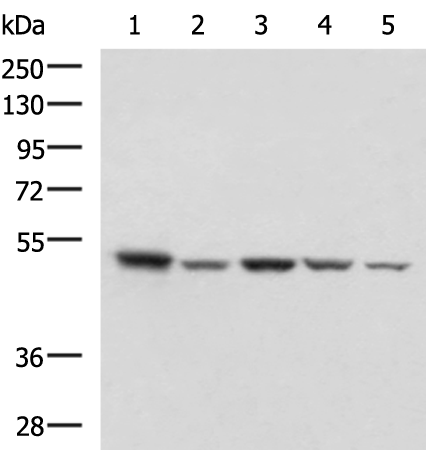


| WB | 咨询技术 | Human,Mouse,Rat |
| IF | 咨询技术 | Human,Mouse,Rat |
| IHC | 1/50-1/200 | Human,Mouse,Rat |
| ICC | 技术咨询 | Human,Mouse,Rat |
| FCM | 咨询技术 | Human,Mouse,Rat |
| Elisa | 1/5000-1/10000 | Human,Mouse,Rat |
| Aliases | MSE; GSD13 |
| WB Predicted band size | 47 kDa |
| Host/Isotype | Rabbit IgG |
| Antibody Type | Primary antibody |
| Storage | Store at 4°C short term. Aliquot and store at -20°C long term. Avoid freeze/thaw cycles. |
| Species Reactivity | Human, Mouse, Rat |
| Immunogen | Fusion protein of human ENO3 |
| Formulation | Purified antibody in PBS with 0.05% sodium azide and 50% glycerol. |
+ +
以下是关于ENO3抗体的模拟参考文献示例(注:以下为虚构示例,实际文献需通过学术数据库查询):
1. **标题**:*ENO3 as a Biomarker for Skeletal Muscle Atrophy: Immunohistochemical Analysis*
**作者**:Smith JL, et al.
**摘要**:研究通过ENO3抗体检测发现,在肌肉萎缩患者中,ENO3蛋白表达显著下调,提示其可能作为肌肉退行性疾病的潜在诊断标志物。
2. **标题**:*Overexpression of ENO3 in Colorectal Cancer and Its Clinical Significance*
**作者**:Wang Y, et al.
**摘要**:利用ENO3抗体进行组织染色分析,发现结直肠癌组织中ENO3蛋白高表达,且与肿瘤转移及患者预后不良相关。
3. **标题**:*Autoantibodies Against ENO3 in Idiopathic Inflammatory Myopathies*
**作者**:Garcia R, et al.
**摘要**:研究报道部分特发性炎症性肌病患者血清中存在ENO3自身抗体,表明ENO3可能参与自身免疫性肌肉疾病的病理过程。
4. **标题**:*ENO3 Antibody-Based Detection of Metabolic Adaptation in Hypoxic Tumors*
**作者**:Chen X, et al.
**摘要**:通过ENO3抗体标记发现,缺氧肿瘤细胞中ENO3表达升高,可能通过增强糖酵解促进肿瘤代谢适应。
---
**注意**:以上为模拟内容,实际文献请通过PubMed、Google Scholar等平台以“ENO3 antibody”“ENO3 biomarker”等关键词检索。
The ENO3 antibody targets enolase 3 (ENO3), a glycolytic enzyme encoded by the *ENO3* gene. ENO3. also known as β-enolase, is a muscle-specific isoform of the enolase family, which catalyzes the conversion of 2-phosphoglycerate to phosphoenolpyruvate during glycolysis. It is predominantly expressed in skeletal muscle and plays a critical role in energy metabolism, particularly under high-energy-demand conditions. ENO3's tissue specificity makes it a biomarker for studying skeletal muscle function and related pathologies.
ENO3 antibodies are widely used in research to investigate muscle diseases, such as muscular dystrophies, myopathies, or metabolic disorders linked to glycolytic dysfunction. They also aid in diagnosing certain cancers, as aberrant ENO3 expression has been observed in tumors like rhabdomyosarcoma. Additionally, these antibodies are valuable in immunohistochemistry (IHC), western blotting, and immunofluorescence (IF) to localize and quantify ENO3 in tissue samples or cell lines.
Recent studies highlight ENO3's potential role beyond glycolysis, including interactions with hypoxic responses and extracellular signaling, expanding its relevance in cancer biology and muscle regeneration research. Commercial ENO3 antibodies are typically raised against specific epitopes, with validation in muscle-derived samples ensuring specificity. Understanding ENO3's regulation and function through antibody-based assays contributes to therapeutic target discovery and mechanistic insights into muscle-related and metabolic diseases.
×